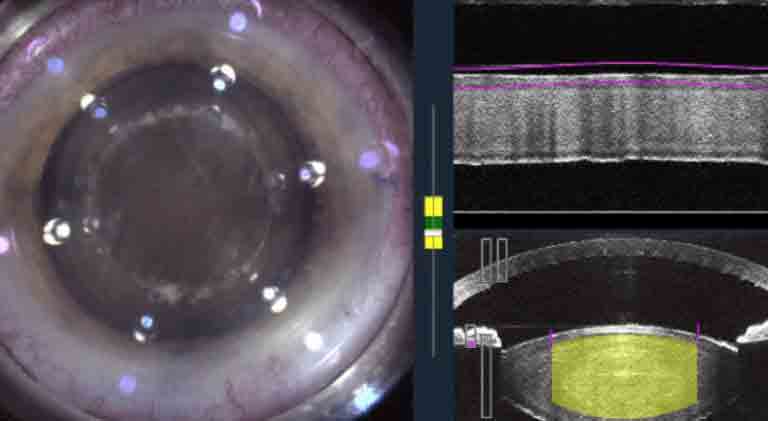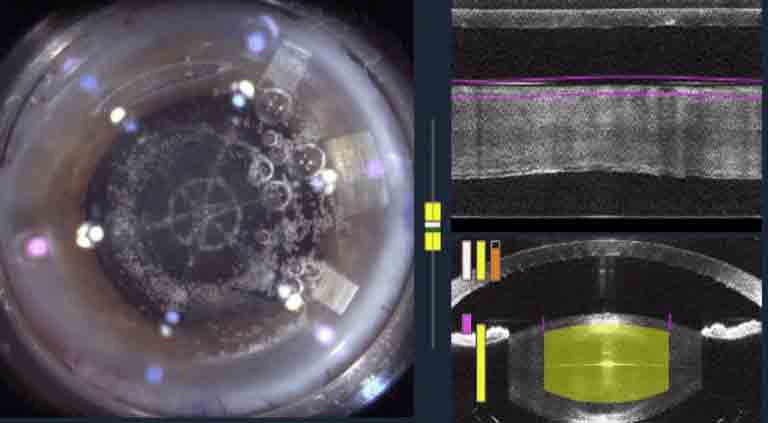FEMTOSECOND LASER CATARACT SURGERY
What we are most likely to find in this article:
What is Laser Cataract Surgery?
Advantage and Disadvantages Aspects of Laser Assisted Cataract Surgery
Different Lasers available for Cataract Surgery
Cost of Laser Cataract Eye Surgery
Insurance Coverage for Laser for Cataract Surgical Treatment

The laser procedure, lasting a couple of minutes, is simple and easy. It starts with the patient being rolled into the laser suite. Everything to be operated upon is confirmed as per protocol before the surgery. Drops are then placed in the eye to dilate and numb the eye. A medical marking pen is used to make specific markings on the eye. Next, an eye retainer is placed in the eye to keep the eyelids separated and the eye open for ease of operation and the laser is positioned over the patient. This is a non-invasive procedure and consequently the eyes will not be prepped with any kind of instillation of drops that can sting, such as Iodine which can interfere with the efficiency of the laser. Throughout the quick procedure, the patient will be asked to look at a blinking red light. This red light is very bright and can also be seen through advanced cataracts. The docking mechanism is then engaged and the Femtosecond laser works to carry out the instructions previously programmed into it by the surgeon. The laser will first make an opening in the capsular-hexis (lens bag) and after that followed by a patterned breakup of the lens. The laser can cut the lens into 2, 4 or 6 pieces, or it can also be chopped into dices of various sizes like 250 or 500 microns, depending upon the commands provided to the laser. Additionally, the center core may be delineated and the depth of these lenticular cuts can once again be controlled by the laser. Next, 1 or 2 precise incisions are made to fix the astigmatism. The length and the distance from the center and the depth of each astigmatic keratotomy incision can be coordinated independently through the settings in the laser. Last but not the least, one or two side-port openings and the main cut is made with the help of the laser. At all times during the procedure, a real-time image of the lens and cornea are presented on a monitor. After the laser has done its task, the patient is required to be moved to the operating room where the surgeon will remove the lens fragments left in the eye and insert a new Pi (lens).

Advantage and Disadvantages of Laser Assisted Cataract Surgery
There are a number of great advantages of femtosecond laser cataract surgery. The surgeon can design the exact openings and pattern of breaking up the lens pieces through the settings in the laser, offering immense flexibility. The plan for the laser is generated by performing various tests including obtaining a colored image of the surface of the eye and measuring the length of the eye with these measurements being fed into the laser. A detailed clinical slit exam is also considered necessary due to the fact that the surgeon will need to assess the thickness, color, and hardness of the lens. Pupil dilation, any type of weakness in the support of the lens or imperfections on the lens capsule need to be accounted for.
All the information obtained during the eye exam leads to a plan. This plan can then be entered into the software of the Femtosecond laser and any modifications can be programmed. In special cases, the femtosecond laser may be the best option. If the support of the lens is weak, working on the capsule by hand can lead to further weakening of the support. Consequently, in this scenario, laser assisted cataract surgery would be safer as it does not strain the lens capsule or its support.
This rings true in extreme cataract cases where trauma has weakened the lens support. The Femtosecond laser is also advantageous in making openings in the lens of the eye with a thick capsule, which may be difficult proposition manually. In patients with white or red cataracts, the Femtosecond laser also holds an advantage. For these patients the capsule needs to be stained manually to be visualized and it still may be challenging to get a good view of the capsule. The Femtosecond laser overcomes this as it utilizes imaging in real time and cutting vertically avoids any kind of rubbing on the Zonular support system.
The opening in the capsule can even be contained by the laser down to a tenth of a millimeter and the diameter can be made to change over a large range, for example 4.2 to 6 mm. The Femtosecond laser systematically makes an opening of the desired shape and diameter, and thus size depending upon the implant to be inserted, which is challenging to create manually, as was the practice in earlier days. An experienced surgeon may be experienced in making the openings, yet in some cases the shape might be too irregular or oval. When fitting Pi in eye, the more circular, central and defined the opening the better it is. For Restor and Tecnis multifocal lenses, the openings are rather smaller sized than for Crystalens.
Particularly with the Crystalens implant, a symmetrical opening is essential. Otherwise, chances of torque in the lens known as Z-Syndrome may develop. If the bag were to tear, Crystalens cannot be embedded. The Femtosecond laser’s exactness is equally helpful in cut creation. The precise openings allow the entry and exit of the instruments and also the insertion of the Pi without excessive stress and consequently, unintended enlarging of the cut, preventing any type of wound leakage at the end of the surgery and facilitating faster healing.
The splitting of the lens by the Femtosecond laser is useful since it is done without any stress on the capsular bag or the Zonular support system. The depth of the cuts in the lens can be precisely controlled in real time. The energy is delivered from the bottom towards the top, permitting gas, created by transition of the lens material into plasma, to escape as well as permitting the subsequent beam to work without hindrance from gas bubbles. In thick cataracts, the bottom is challenging to perceive, so the capsule can be accidentally ruptured. Real-time image display with the Femtosecond laser allows the ability to be precise as a result, with the surgeon able to see what he/she or the laser are doing, thus allowing the surgeon to avoid the bottom of the bag. This is of tremendous benefit when making use of the laser for cataract or Prelex procedure.
Disintegrating difficult lenses is time consuming with conventional sound wave technology. Femtosecond lasers reduce time and energy called for to complete the breaking of the lens. Additional advances in laser technology will be much more assertive in removal of cataracts. The age of robots is red-hot and approaching, and may greatly reduce human intervention in the surgeon, while not doing away with it entirely. Perhaps eventually, robots might safely execute Cataract or Prelex surgery. As of the moment, skilled cataract surgeons are still required. The technology is advancing at a fast speed and we keep pace with it.
Disadvantages of Laser Assisted Cataract Surgery
It increases the time required for overall cataract surgery. There are 2 steps. A person has to lie still for couple of minutes under the docking of femtosecond, lasers and may create redness of the eye, as well as there is the increased cost.
Different Lasers readily available for Cataract Surgery
There are many lasers offered for Femtosecond laser cataract surgery. The following are FDA approved:
– Lensx Laser – Alcon (OCT/Ocular Coherence Tomography based)
– Catalys Laser – Optimedica (OCT based)
– Victus – Bausch & Lomb (Real time OCT based)
– Lensar – (Scheimpflug based)
A usual question is, which is the best? Each laser has its own strengths and benefits. It is important that the Pi in eye surgeon has access to more than one of these lasers so he or she can select the best for the particular eye, depending upon the specific circumstances of each patient’s eyes.
Cost of Laser Cataract Eye Surgical Procedure
Femtosecond laser cataract surgical treatment requires imaging and calculations. Ocular Coherence Tomography or OCT imaging is required to plan the cataract eye treatment with the laser. OCT is like a colored MRI. It checks the structures of the eye in great detail. Only then can the precision of the femtosecond lasers can be used. This technology is expensive. Most surgeons charge in between 1,800 to 3,200 Dollars per eye. At our Los Angeles Centers, we offer 36 month no interest, no down payment, and thus affordable equated monthly installments.
Insurance Coverage for Laser for Cataract Surgery
The Medical and Visual insurances do not cover for the diagnostic imaging or testing to prepare for the surgery. The Center for Medical Services came out with a ruling which outlines this plan. Still, it is a good idea to check with your insurance company. If you are not sure about your insurance coverage and want us to find the exact coverage for femtosecond laser cataract surgery please send us a copy of your insurance card by fax to (805) 230 2199 or Please take a pic of the insurance card with your smart phone and text it to (310) 235 3816., and leave the rest for us to find out on your behalf
Procedure: Laser Cataract Surgery
Synonyms:
Indications:
Contraindications:
Detection Analysis:
Equipment for Surgery:
Variations in procedure:
Before the Procedure:
Day of Procedure:
Surgery Steps:
After the Operation.
Eliminating Risks:
Comparing with other procedures: